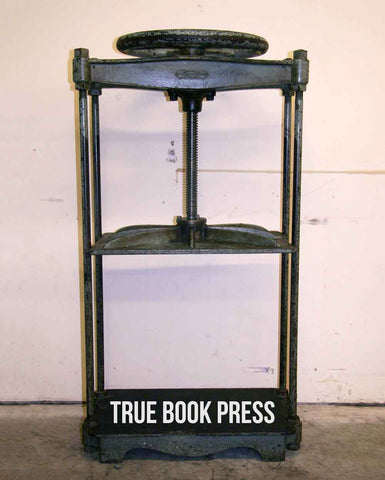What is the difference between a book press and a copying press?
Share
After picking up an antique book press, I decided to do some digging to find out the age of this lovely iron piece, or perhaps even find a make and model since this particular press only stated ‘pat app’d for’. After some cursory Googling it was quickly revealed that, well, this wasn’t a book press - and what we commonly know as the 'book press' isn't that at all. They are letter copying presses.
 But…What exactly is a letter copying press? Apparently, back in the 1800s these ‘book presses’ were used for making copies of letters into blank books. A copying book, which sounds to be a blank book filled with thin tissue paper, was used inside of these machines. Once a letter was freshly written, it was sandwiched inside the book. An oiled sheet sat atop a blank page, while the fresh letter sat under it, and another oiled sheet below the fresh letter. The tissue paper was dampened to encourage the ink to transfer onto the tissue paper when the book was being pressed. Of course, we know when printing, everything prints backwards. This was the reason the paper was made from tissue, so the ink could easily be seen from the other side! It might seem tedious today, but this was before the invention of carbon paper, so having such a device around saved more time than having to write everything out a second, third or fourth time.
But…What exactly is a letter copying press? Apparently, back in the 1800s these ‘book presses’ were used for making copies of letters into blank books. A copying book, which sounds to be a blank book filled with thin tissue paper, was used inside of these machines. Once a letter was freshly written, it was sandwiched inside the book. An oiled sheet sat atop a blank page, while the fresh letter sat under it, and another oiled sheet below the fresh letter. The tissue paper was dampened to encourage the ink to transfer onto the tissue paper when the book was being pressed. Of course, we know when printing, everything prints backwards. This was the reason the paper was made from tissue, so the ink could easily be seen from the other side! It might seem tedious today, but this was before the invention of carbon paper, so having such a device around saved more time than having to write everything out a second, third or fourth time.
As the decades passed, it became more important to have loose copies of documents rather than ones bound inside books. Newer copying presses used a roller and plate, with the fresh letter and blank sheet cranked through to create duplicates; makers claimed these machines could produce 100 copies in as little as two minutes. Suddenly, these bizarre book presses I had seen on eBay and other sites started to make more sense…They were combination presses, which was a traditional copying press, but also featured a roller and plate on top. This makes for an interesting looking contraption that can be used to make a bound book of copies, or individual loose-leaf duplicates.
Aside from these two, there even existed ‘hydrostatic copying presses’ that connected to the pipes of offices, with a small amount of water running through the machine to help apply and keep pressure so that ‘even a lady could press as good a copy as the strongest man’. Fascinating. I wonder what happened to all these old presses. Take a look at the ‘gear screw presses’ below the hydrostatic (see below, tap to enlarge). These were images pulled from a listing on eBay - I purchased these advertisements and will scan them at a high resolution to replace these low quality screenshots. What a great piece of history!


Wondering if your press is a true book press or a copying press? Typically you can tell the difference by the amount of ‘daylight’, or space, between the base of the press and the platen. True book presses have well over 8+ inches of daylight between the two, accommodating several books at one time. A copying press usually only has 4 or less inches of daylight, as only a single copying book was pressed inside at any given time. While I still haven't found the make and model of my 'book press', I'm excited to have learned its true use and history. Want more information? Here are a few sites I referenced:

5 comments
I have a W MITCHELL BIRMINGHAM LONDON It was ina very bad condition so I started torefurb the unit.
I would like to know how I can determine when these were made, as I am not able to locate the firm that made these units .
I have an identical press to the one you have is super heavy and it’s 5 feet tall the brand is the (standard machinery co) I believe the company started around 1889 and lasted until 1956
Link to high res images of the catalog pages:
https://drive.google.com/drive/folders/1Ki7g8SLls72BWuNmXtc5nwbqj83m2_o9?usp=sharing
I was excited to see the two images of copy presses. I was able to match my press to one of the photos which confirms it is a Fairbanks 8C railroad pattern. Any way to obtain a better image from you?
Thank you for your concise explanation of the difference between a book press and copying press. I too recently stumbled upon a muddy, dusty old copy press sitting on the floor of an antique store. It had two ornate dolphins on either side of the cranking mechanism and I mistook it for a small letter press or the like. A friend suggested that it was a nipping press which I had to google and fell down the google rabbit hole until I found your site. I now understand what my press actually is. The only difference is that most presses that are pictured have a cast iron plate bottom to them and mine is mounted on a block of what appears to be walnut wood 3-1/2 inches thick by 24-1/2 inches long by 12 inches deep. I thought that maybe it was a replacement part for the missing iron plate bottom but have since found one other picture exactly like mine with dolphins and the same wood block base. So is the wood base a factory piece and would you know about how old my press might be. Thanks.